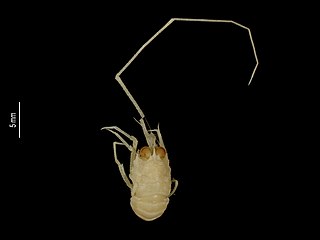
Munidopsis serricornis is a species of squat lobster. It is widely distributed in the world's oceans, being found in the eastern Atlantic Ocean, the western Atlantic Ocean, and the Indo-Pacific. It grows up to a carapace length of 20 millimetres (0.8 in).

Eumunida picta is a species of squat lobster found in the deep sea. The species is strongly associated with reefs of Lophelia pertusa, a deep-water coral, and with methane seeps. It is abundant in the western Atlantic Ocean, where it is found from Massachusetts to Colombia.

Eumunida is a genus of squat lobsters. There are 29 recognised species in the genus, the majority of which are from the Pacific Ocean:
Anomoeomunida is a monotypic squat lobster genus in the family Munididae. The sole a species of is Anomoeomunida caribensis. It occurs in the western Atlantic.

Anoplonida is a genus of squat lobsters, which are flattened dorsoventrally, in the family Munididae, containing the following species:

Bathymunida is a genus of squat lobsters in the family Munididae, containing the following species:

Crosnierita is a genus of squat lobsters in the family Munididae, containing the following species:
Enriquea leviantennata is a species of squat lobster in a monotypic genus in the family Munididae.

Lauriea is a genus of squat lobsters in the family Galatheidae, containing the following species:

Neonida grandis is a species of squat lobster in a monotypic genus in the family Munididae.

Onconida is a genus of squat lobsters in the family Munididae, containing the following species:

Raymunida is a genus of squat lobsters in the family Munididae, containing the following 11 species:
Setanida cristata is a species of squat lobster in a monotypic genus in the family Munididae.

Shinkaia crosnieri is a species of squat lobster in a monotypic genus in the family Munidopsidae. S. crosnieri lives in deep-sea hydrothermal vent ecosystems, living off of the chemosynthetic activity of certain bacteria living on its setae.
Munidopsis tuberosa is a species of squat lobster, first isolated from deep waters off Taiwan. M. tuberosa is similar to M. granosicorium, but it differs by the configuration of its carapace and rostrum.
Munidopsis echinata is a species of squat lobster, first found in deep waters off Taiwan. M. echinata is similar to M. colombiana, but differs by lacking an antennal spine on its carapace and having a rather longer antennal peduncle.
Uroptychus anacaena is a species of chirostylid squat lobster first found in Taiwan. U. anacaena and U. anatonus are similar but can be distinguished from each other by the shape of their 4th sternite and the length of their antennal scale. Both species resemble U. maori and U. brucei, but lack a ventral subterminal spine on their first pereopod's ischium.
Uroptychus anatonus is a species of chirostylid squat lobster first found in Taiwan. U. anatonus and U. anacaena are similar but can be distinguished from each other by the shape of their 4th sternite and the length of their antennal scale. Both species resemble U. maori and U. brucei, but lack a ventral subterminal spine on their first pereopod's ischium.
Uroptychus orientalis is a species of chirostylid squat lobster first found in Taiwan. This species is separated from U. occidentalis by its shorter antennal scale and dactyli P2–4 with their ultimate and penultimate spines being subequal in size.
Uroptychus singularis is a species of chirostylid squat lobster first found in Taiwan. This species is distinguished from U. australis by its single, unpaired terminal spine on its flexor margin of pereopods 2–4.









